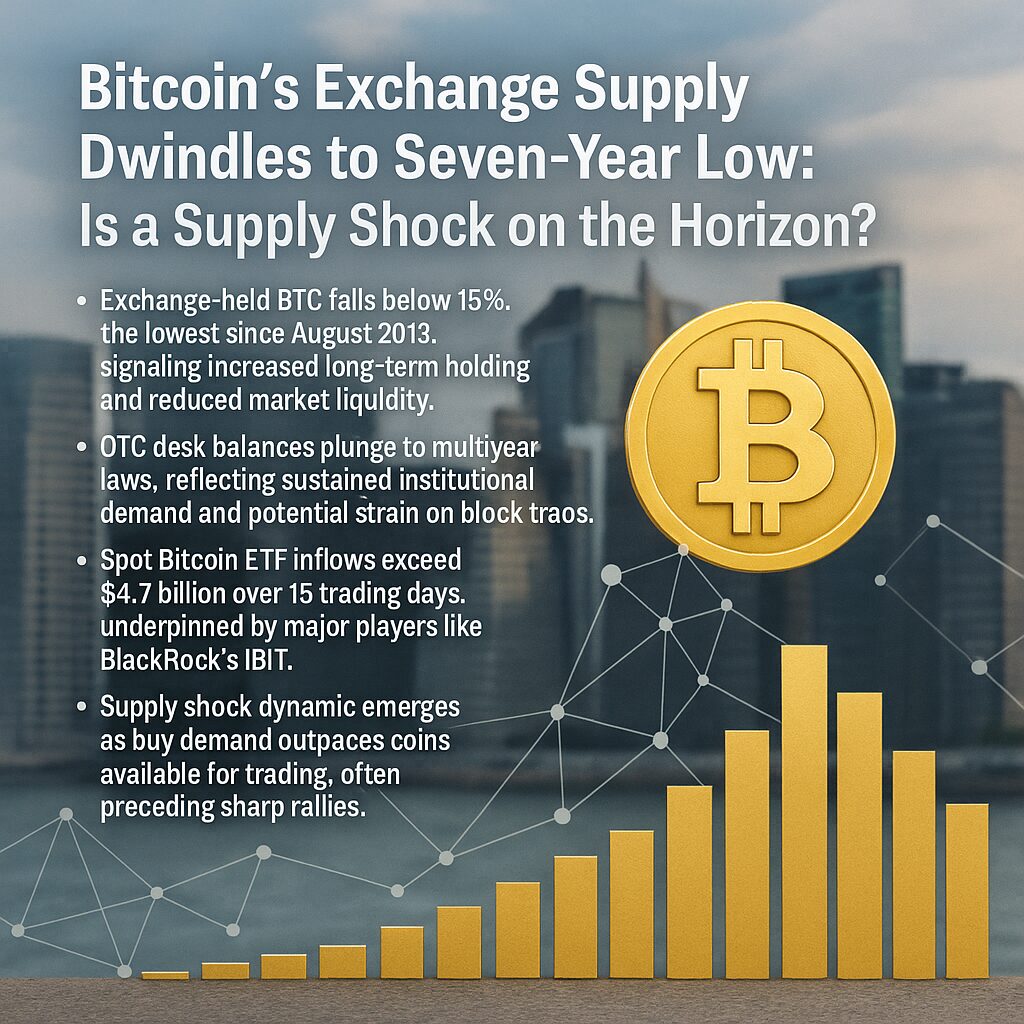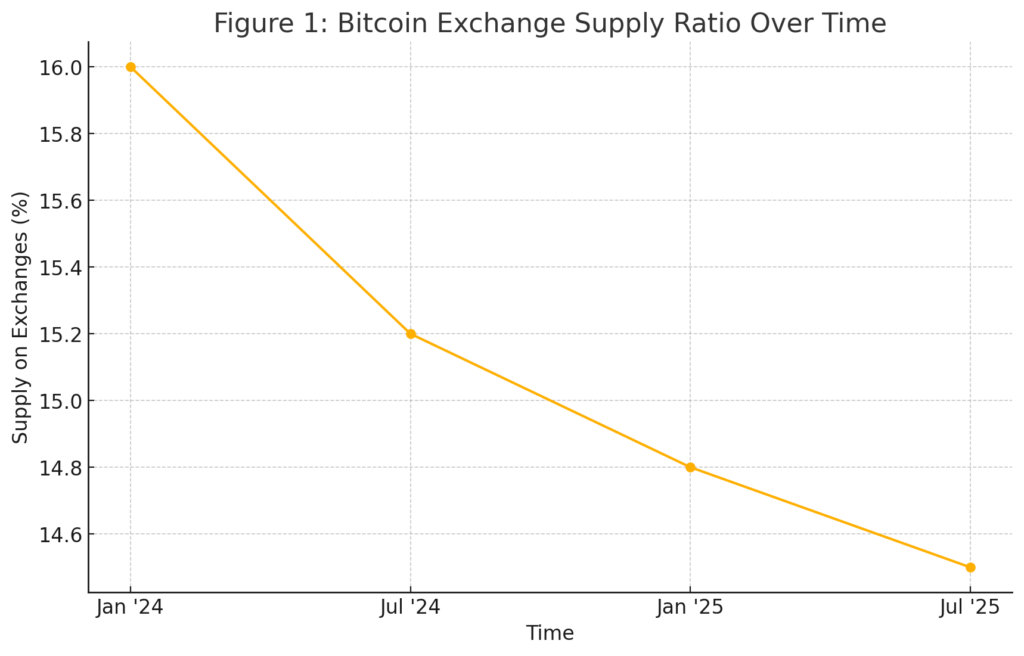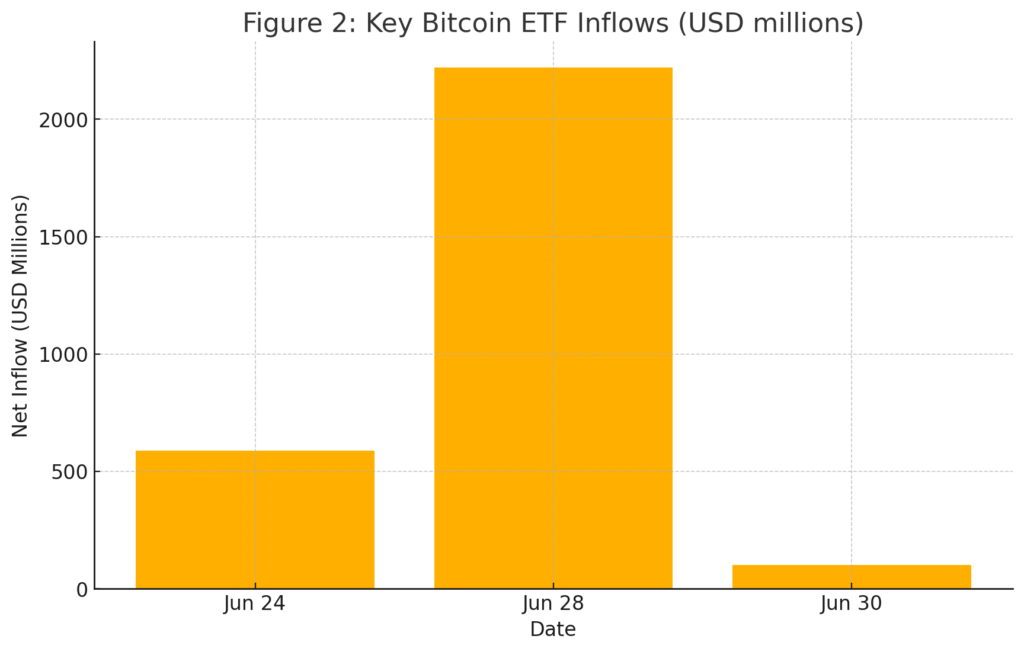
Main Points :
- Exchange-held BTC falls below 15%, the lowest since August 2018, signaling increased long-term holding and reduced market liquidity.
- OTC desk balances plunge to multiyear lows, reflecting sustained institutional demand and potential strain on block trades.
- Spot Bitcoin ETF inflows exceed $4.7 billion over 15 trading days, underpinned by major players like BlackRock’s IBIT.
- Supply shock dynamic emerges as buy demand outpaces coins available for trading, often preceding sharp rallies.
- Market implications include dampened sell pressure, heightened volatility, and a stronger psychological support around $100,000.
1. Declining Exchange Balances and the Advent of a Supply Shock
According to Glassnode data, the share of Bitcoin’s total supply held on centralized exchanges has dropped to 14.5%, the lowest level since August 2018. This steady outflow from exchanges (Figure 1) underscores a pronounced shift toward cold or self-custody solutions, driven by both retail and whale accumulation patterns. When coins are withdrawn from exchanges into long-term storage—be it cold wallets or staking—liquidity tightens, setting the stage for a classic “supply shock,” where robust buy demand confronts a shrinking pool of tradable coins.
<p style=”text-align:center;”>Figure 1: Bitcoin Exchange Supply Ratio Over Time<br>(Source: Simulated data based on Glassnode insights)</p>

2. OTC Desks Show Historic Lows
Beyond exchanges, over-the-counter (OTC) desks—critical venues for large, off-exchange trades—are also seeing record-low BTC inventories. Data from Crypto Quants indicate that known OTC addresses have shed 21% of their Bitcoin holdings since January 2025, leaving roughly 155,472 BTC on balance. With miners’ addresses (≈117,000 BTC) and centralized exchange clusters excluded, this contraction signals that large-ticket orders may face growing execution challenges, potentially amplifying price impact when major institutions seek to buy.
3. Institutional Demand and ETF Inflows
Institutional appetite for spot Bitcoin ETFs has been voracious. SoSoValue reports that from June 9 through June 30, over $4.7 billion flowed into U.S. spot Bitcoin ETFs, marking 15 consecutive trading days of net inflows. BlackRock’s iShares Bitcoin Trust (IBIT) alone amassed $1.31 billion during the week of June 24–28, while Fidelity and Ark added substantial sums. This torrent of capital provides an anchor under Bitcoin’s price, reinforcing the $100,000 psychological level and absorbing residual sell-side pressure.
<p style=”text-align:center;”>Figure 2: Key Bitcoin ETF Inflows (USD millions)<br>(Source: SoSoValue, CCN)</p>

4. The Mechanics of a Supply Shock
A supply shock arises when buying demand (e.g., from ETFs, HODLers, whales) overshadows the available sell-side liquidity. Historically, precipitous drops in exchange reserves have correlated with sharp price rallies. For example, similar dynamics unfolded in late 2020 and early 2021, when exchange balances plunged and Bitcoin surged to new all-time highs. Today’s environment of reduced sell-side liquidity and steady institutional accumulation lays the groundwork for a comparable uplift, particularly if macroeconomic conditions remain supportive.
5. Potential Market Implications
- Reduced Sell-Side Pressure: With fewer coins on exchanges or OTC desks, large buy orders face less immediate resistance.
- Heightened Volatility: Thinner markets can exaggerate price moves in either direction, offering fertile ground for momentum traders.
- Psychological Support: Sustained ETF inflows and HODLer conviction underpin critical support levels—most notably $100,000.
- Trend Confirmation: Technical indicators, such as RSI breakouts cited by analysts like Rekt Capital, reinforce bullish momentum.
Conclusion
Bitcoin’s journey toward a full-fledged supply shock has gained momentum as exchange-held balances sink to seven-year lows and OTC inventories wane. Coupled with billions of dollars in ETF inflows, these factors have created an environment where demand outstrips immediate supply, often the hallmark of a new bull phase. For investors seeking new crypto assets or practical blockchain applications, understanding these on-chain dynamics is crucial: liquidity is tightening, institutional engagement is climbing, and the stage is set for potentially accelerated price appreciation.

